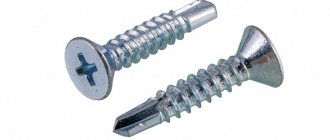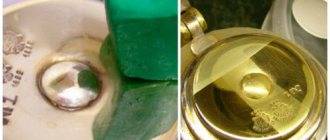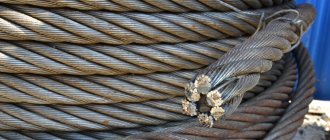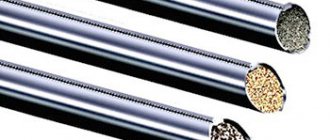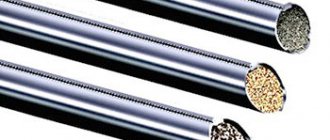GOI paste, developed back in the distant 1930s in the bowels of the State Optical Institute, has not lost its former popularity even now. You can hardly find an owner who doesn’t have a piece of this green (and sometimes other colors) product hidden somewhere. Let us remind you how to use GOI paste and give some tips on the safe use of this “greetings from the past.”
Types of GOI paste
Today there are four types of GOI paste on the market:
- No. 4 is used for primary processing of the material, if it has not been processed before;
- No. 3 gives the surface a matte appearance, eliminating all remaining strokes;
- No. 2 and No. 1 finish what their “older relatives” started, making the surface glossy and finishing the polishing.
The type of GOI paste depends on the size of the abrasive used in its manufacture. The paste was produced in a hard (bar) or softer (box) version. Why do we talk about GOI paste in the past tense? The fact is that at the moment, not a single Russian plant has the right to produce this product due to the presence of chromium oxide in its composition, which is hazardous to health - this compound is a carcinogen, i.e. it accelerates the development of cancer cells.
General information
GOI paste - what is it?
The abbreviation stands for State Optical Institute, where this cleaning powder was created in the 30s of the last century. Externally, this paste is a greenish mass, which is sold in the form of a smooth block or sealed in a jar.
Paste composition
The main ingredient of the paste is chromium oxide. Its concentration can be different, which determines the characteristics of the drug and its granularity. The more chromium oxide in the composition, the coarser the mass.
REFERENCE! This paste is harmless to humans, due to the fact that trivalent chromium oxide is used to create it, and only 6-valent chromium oxide is dangerous to people. However, when working with this drug, it is better to wear a mask and safety glasses, as when using it, dust may arise that irritates the human mucosa.
Types of pasta
There are several types of pasta that differ in grain size. Each of them has its own number.
- Number 1 - thin. It has a dark color, shimmering with green. Designed for grinding in or finishing the material, and also gives it shine and shine.
- Number 2 - thin. It has a dark green color. Used for polishing.
- Number 3 is average. Has a pure green color. Designed to protect minor scratches and unevenness, providing the material with a matte finish.
- Number 4 - rude. It has a light green color and can scratch off the top layer of material the most. Designed to protect large scratches left by other abrasives.
REFERENCE! The most popular is paste composition number 2, which is excellent for precious items, as well as plastic and glass.
If the green mixture has dried out, it can be made soft again. This is done using machine oil. You will need to grind a small piece of paste into fine crumbs and drop 3-4 drops of machine or other technical oil onto it. The resulting mixture should be microwaved for 30 seconds, and then grind the components into a homogeneous mass.
Preparation for polishing
The action of GOI paste consists of the work of small abrasive particles, which, through friction, erase irregularities from the surface. Before you start polishing, you need to prepare a small piece of soft cloth and soak it in gasoline (it is not necessary to use car fuel; gasoline for lighters will be enough). A small amount of paste is applied to the material. Using the prepared tool, you should first wipe the unnecessary metal surface to remove excessively large abrasive particles, otherwise the desired surface will not be polished, but damaged. You don't want to see a scratch on the surface after polishing, right?
How to remove scratches, dents and chips
Medium scuffs and scratches can be buffed out with microfiber or felt using a metal cleaner. Polishing is carried out pointwise, in a circular motion until the defect is eliminated. Then clean the glass with a napkin.
A manicure file or nail polishing block will help get rid of chips, deep scratches and small dents on the steel surface. Also, a fiberglass brush is suitable for this purpose. Working with abrasive materials and brushes must be precise and careful so as not to add new damage.
After abrasive treatment, the product should be polished.
It is better not to deal with serious surface defects on cases made of gold, sputtered or coated with precious metals at home and contact a professional craftsman who will sand and renew the coating.
If the product is seriously damaged, it is better to have it polished by professionals in a watch or jewelry workshop.
Polishing
After preparing the polishing tool, you can begin the process. To properly polish a surface, you need to carefully, without sudden movements or strong pressure, rub the desired area with polish until the surface becomes smooth. If necessary, you should return to the previous stage (if the surface requiring polishing has a large area, the GOI paste will quickly run out).
We recommend: 5 ways to use salt to remove unpleasant odors and dampness
If the product has many flaws, you should use not just one type of paste, but several. So, for initial treatment, GOI paste No. 4 is applied to the rag, as the number of flaws decreases - No. 3, and so on, until the surface takes the desired form.
The treated element should be washed with kerosene in order to remove any remaining abrasive from it. In the absence of kerosene, ordinary running water can be used, but this is not recommended, since under improper conditions there is a high risk of rust. Considering that many polish the necessary surfaces in the garage, where there is often high humidity, this point should not be discounted.
Advice
Carry out polishing work outside residential premises. The ideal place would be a garage, workshop with good ventilation, or some open space. Polishing with GOI paste requires rinsing with kerosene, and inhaling its vapors is dangerous to health.
Features of the material and scope of application
Organic glass is produced from acrylic acid through various chemical reactions. This material is similar in various parameters to ordinary glass, but its nature is organic (hence the name of the material). There are several synonymous words - plexiglass, acryplast, carboglass, etc.
Among the main characteristics of plexiglass we can highlight:
- ease;
- softness;
- ability to easily transform;
- flexibility during processing;
- high throughput;
- When exposed to certain chemicals, plexiglass decomposes.
Polishing soft metal products
GOI paste can be used to polish items made of any metals, including soft ones such as silver and gold. This procedure will help restore the former shine of your favorite utensils. But polishing such objects requires a special approach.
Let's look at the polishing process using silver spoons as an example.
- Before carrying out the procedure, you should thoroughly wash the spoons and clean them with a stiff brush (an ordinary toothbrush is ideal) with tooth powder applied to it.
- Then a solution is prepared containing ammonia, tooth powder and soap shavings. All this is mixed until completely dissolved.
- Spoons are soaked in the resulting solution.
- Then the mixture should be put on fire and brought to a boil.
- The spoons are removed, washed in running water and then wiped with GOI paste.
It would be better to use types of paste No. 1 or No. 2, since the other two can leave scratches on expensive utensils.
Working with cars
GOI paste is used for grinding and polishing body parts, headlights, mirrors and car windows. The body is processed with a power tool with felt attachments, the windows and headlights are polished with flannel. The type of paste used depends on the planned work:
- The medium composition (No. 3) is used to polish body parts. After sanding, the surface appears matte and requires finishing.
- Fine compounds (No. 2 and 1) are used to polish body parts and glass elements.
To determine which operation to start body work with, you need to run your fingernail over the problem area. If the nail clings to scratches, then the body is first sanded and then polished. If the nail does not cling to the scratches, polish it immediately.
Before work, body parts are moistened with glass cleaner or water. The speed of the polishing wheel is from 1100 rpm. A circle is driven around the body without stopping, maintaining an angle of 4-6 degrees between the nozzle and the part. The remaining paste is removed with warm water under low pressure.
Before polishing mirrors, glass and headlights, surrounding parts are covered with plastic film. The elements to be treated are pre-washed with either a soap solution, a glass cleaner solution, or a solution of technical alcohol. After washing, wipe dry.
When working, use a machine with a grinding wheel or a drill with a special attachment. The paste is ground into powder and mixed with machine oil. One drop of oil is needed per spoon of powder. The mixture is applied to a grinding wheel and rubbed over the surface with overlapping stripes. During polishing, make sure that the product does not overheat. Remaining paste is removed with a paper towel. Deep scratches are not suitable for polishing; they are filled with a colorless leveling compound.
Polishing plastic and glass products
It’s amazing but true: GOI paste can be used to restore old equipment to its former beauty! To polish plastic products, you should use GOI paste type No. 2, since more abrasive types can damage soft plastic.
We recommend: Cleaning copper and silver coins in different ways: vinegar, soda, salt and other substances
It is worth noting that when polishing equipment, kerosene, gasoline and running water are not used. Only abrasive is applied to the rag, without the use of auxiliary products. The process itself is no different from polishing other materials and objects.
Where should you not use GOI paste?
It would seem that GOI paste is a universal remedy. But no, there are surfaces that should not be touched with this polish due to the fact that such a procedure will either make no sense or cause harm.
Firstly, you should not polish mechanical watches with GOI paste. Types No. 1 and No. 2 will only enhance the visibility of small scratches and emphasize them, and pastes No. 3 and No. 4 can simply erase the top layer of metal, causing the watch to lose its former luster.
You should also not use this product to polish sapphire crystals on watches - there will simply be no effect, since sapphire crystal is very durable.
Analogs
If the specified composition cannot be dissolved, or the resulting effect does not correspond to the desired one, you can replace this technical product with a complete analogue. For household needs, many craftsmen choose products from foreign manufacturers, which are distinguished not only by high technical characteristics, but also by a long shelf life, affordable storage conditions, and prices. Here are popular offers from foreign manufacturers:
- Rupes;
- Dialux;
- Depural Neo.
Precautionary measures
At the beginning, we mentioned that GOI paste is not currently produced in Russia due to its toxicity. However, it is sold freely in stores whose owners were able to supply the well-known polish. And if a person purchases this remedy, he should know some precautions in order to avoid tragedy.
- You need to use GOI paste extremely carefully, avoiding contact of its particles with the mucous membranes of the eyes and nose. If you are unable to protect yourself from this, immediately rinse the affected surface with running water and call an ambulance.
- Use a respirator or at least a medical mask when working with polish, especially when polishing metals using a cloth soaked in gasoline. You should not expose your body to the risk of poisoning from vapors of chemically complex substances.
- Keep children away from polish storage areas.
- Work with the product while wearing gloves to protect the skin of your hands.
So, GOI paste is an effective, but unsafe remedy. Even if you have used it for polishing many times, you should always be on guard when working. If the situation allows, it is better to use more gentle methods.
Rules for general watch care
A wristwatch is an accessory that is in constant use. We get so used to them that sometimes they seem to be an integral part of us. They say that without a watch is like without hands. In order for this part of us to serve as long as possible, it requires care and attention. Spend a little free time and your watch will shine like new. To extend their service life, try to follow simple care rules:
- After wearing, it is better to put your watch away in a separate box, avoiding contact with other small household items.
- Do not delay replacing cracked glass to prevent dust from entering the dial and mechanism.
- Remove your watch at night to avoid damaging it while you sleep.
- Leave your watch in the locker room when you shower, bath or sauna. High temperatures and humidity will not do them any good.
- Periodically carry out professional preventive maintenance in specialized workshops.
A watch storage box is one of the most popular ways to protect a watch from external influences.
In order to enjoy wearing your favorite wristwatch model for as long as possible, you need to ensure proper care for it. As it turned out, no special effort is required in this direction - your free time, desire and quite accessible materials. But, if you are not sure that you can cope on your own, then repair shops are always at your service.
Regular cleaning will give the product a stylish appearance, extend the life of the mechanism, and remove scratches and damage.

